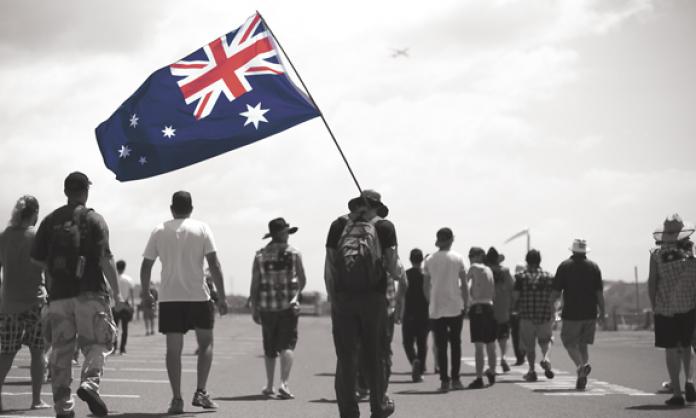Australia has an active and influential right wing movement, despite having one of the strongest social democratic movements in the world.
Inciting racism against refugees, Indigenous people, African youth and others is their stock in trade, as is promoting “family values” and opposing marriage equality and the Safe Schools program. They challenge science by denying climate change, and they promote Christianity in an overwhelmingly irreligious country.
Their strength and confidence today can be largely attributed to an organised wave of reaction known as the “culture wars”.
The culture wars took off after the 1996 election of the Coalition government led by John Howard. A key battleground was Australian history since the British invasion, with a focus on the treatment of Indigenous people.
Howard’s offensive expanded, targeting the rights of women, migrants, refugees and LGBTI people, within a broader crusade against a “black armband view of history” and “political correctness” and for “Australian values”.
The culture wars were part of a strategy to push back the gains of the 1960s and 1970s – a period of mass radicalisation and campaigning that resulted in significant progress for oppressed and marginalised groups.
The project involved popularising right wing social positions, such as the sanctity of (heterosexual) marriage and the family and the idea of men’s rights, while building a consensus about the need for strong borders and law and order.
The culture wars helped restore the electoral fortunes of the conservative parties. Labor had been in office federally since 1983, and, with the enthusiastic support of the Australian capitalist class, had implemented a reactionary economic agenda including deregulation and privatisation, welfare cuts and attacks on workers’ rights. In contrast to Britain and the US under Conservative Party PM Margaret Thatcher and Republican president Ronald Reagan, social democracy spearheaded neoliberalism in Australia.
With the economic rug pulled out from under them, the Liberals needed a new rallying cry. By whipping up the conservative base and appealing to socially conservative Labor voters, Howard diverted public discontent about Labor’s economic agenda and sowed divisions by attacking progressive social policies and scapegoating particular groups.
This was couched in terms of a struggle between “battlers” and “elites”, a characterisation intended to undermine class consciousness as well as to disarm the only force capable of resisting the neoliberal attacks.
The Howard government squandered wealth from the mining boom years on measures such as tax cuts and subsidies to cultivate a layer of better off workers and self-employed people who would be loyal to the Liberal Party. This was accompanied by ramped-up anti-union rhetoric and a raft of anti-union laws.
Another important element of the culture wars was the promotion of an Australian nationalism focused on traditional conservative values such as patriotism, reverence for the flag and the monarchy, the “Anzac tradition” and so on. Anzac Day and Australia Day have become orgies of jingoism, with anyone who dares question their legitimacy dubbed “un-Australian”.
It has been a successful strategy, and one continued by subsequent Coalition governments, Peter Dutton and Tony Abbott today being the main spokesmen for the conservative culture warriors.
The ‘history wars’
By the 1980s, there was a substantial body of work by “critical historians”, such as Manning Clark and Henry Reynolds, detailing the brutal and genocidal treatment of Indigenous people following colonisation. But telling the truth about Australia’s past was anathema to the right.
In 1985, right wing historian Geoffrey Blainey made a speech criticising the “vocal, richly subsidised multicultural lobby” and arguing that Australia should be “one nation” rather than “a nation of many nations”. He denounced the ABC, schools and universities, and “elite groups” for spreading the view that Australia’s history was “largely the story of violence, exploitation, repression, racism, sexism, capitalism, colonialism and a few other isms”.
Howard, then opposition leader, was a fan. The previous year he had supported Blainey’s attack on multiculturalism and calls for a reduction in the level of Asian immigration.
A black armband has long been a symbol of protest and mourning among Indigenous activists, especially during events celebrating colonisation. In 1988, Aborigines and their supporters wore them at protests against the bicentenary of British invasion. On one occasion, a copy of John Molony’s Bicentennial History of Australia was hurled into the waters of Sydney Harbour as a protest against the lack of attention given to Aboriginal history.
Later that year, Howard produced a paper called Future Directions, which made clear the importance of the history wars to Coalition policy. He denounced “the professional purveyors of guilt [who] attacked Australia’s heritage”. Similar views were expressed by right wing intellectuals associated with journals such as the IPA Review and Quadrant, former Liberal leader Malcolm Fraser and mining boss Hugh Morgan, who railed against the “guilt industry”, which he held responsible for an “Orwellian reconstruction” of the past.
The phrase “black armband view of history” was coined by Blainey in 1993. It was quickly taken up by conservative commentators and politicians, who espoused a “white blindfold” view. And once in government, Howard lost no time going on the offensive. In October 1996, he declared:
“I profoundly reject the black armband view of Australian history. I believe the balance sheet of Australian history is a very generous and benign one … I think we have been too apologetic about our history in the past.”
And again in November:
“This black armband view of our past reflects a belief that most Australian history since 1788 has been little more than a disgraceful story of imperialism, exploitation, racism, sexism and other forms of discrimination … I believe that the balance sheet of our history is one of heroic achievement and that we have achieved much more as a nation of which we can be proud than of which we should be ashamed.”
As one commentator noted, by the end of Howard’s first nine months as prime minister, “it was clear that the desire to project a largely proud, heroic and benign version of Australian history was at the heart of his government’s political philosophy and possibly its electoral strategy”.
Henry Reynolds argued that Howard sought to restore a “white picket fence view of history that minimises women, Aborigines and other minority groups”. Another historian, Anne Curthoys, noted that the November speech had nothing to do with history but everything to do with “an appeal to a political constituency”.
And there was a material issue at hand. The High Court’s Mabo (1992) and Wik (1996) decisions led to extremely limited and wholly inadequate native title rights, but even these were too much for the mining and pastoral capitalists. They wanted the unrestricted right to continue the theft and exploitation of Aboriginal land.
Howard was only too happy to help. He instigated a fear campaign, falsely claiming that the homes of white Australians were under threat from land rights. He admitted that there had been some “injustices” in the past. But, he said, “Our priority should not be to apportion blame and guilt for historic wrongs but to commit to a practical program of action that will remove the enduring legacies of disadvantage”.
This was his justification for refusing to apologise to the stolen generations. But what did his “practical program” consist of? In 1997, he undermined land rights legislation with a 10-point plan that delivered “bucketloads of extinguishment” (of native title rights). In 2004, he abolished the Aboriginal and Torres Strait Islander Commission, a democratically elected body representing Indigenous people.
And in 2007 – using spurious claims and media beat-ups that painted Indigenous Australians as violent, drunken and drug-addicted abusers of women and children – he launched an “emergency intervention” in the Northern Territory. His government sent troops into communities, installed white “business managers” to run them and introduced “income management”. Far from removing the “enduring legacies of disadvantage”, these attacks only added to them.
Refugees, asylum seekers and some migrants were also victims of the culture wars, especially after the 2001 attack on the World Trade Center, when Howard unleashed a wave of Islamophobia as part of the “war on terror”.
People fleeing persecution and poverty – and, in many cases, the invasion of their countries by imperialist countries including Australia – were demonised as a threat to “our values” and “our way of life”, or branded as terrorists. Conveniently for Howard, Labor had introduced mandatory detention in 1992, laying the basis for the barbaric regime of offshore concentration camps we have today.
In 2004, Howard banned same sex marriage, arguing that the nuclear family model of mum, dad and kids was the “bedrock” of society. And there were plenty willing to take it further, painting LGBTI people as deviants and a threat to “civilisation as we know it”. In 2006, Howard introduced a program funding the employment of religious chaplains – but not qualified counsellors or youth workers – in schools.
In a speech celebrating the 50th anniversary of Quadrant in 2006, he boasted that “political correctness” was now dead in Australia, but warned that “we should not underestimate the degree to which the soft-left still holds sway, even dominance, especially in Australia’s universities”.
In her book Governing Change: From Keating to Howard, academic Carol Johnson sums up Howard’s legacy:
“There was no need to reconstruct Australian identity; white, heterosexual, Anglo-Celtic males could once again rest assured in their central role in Australian political culture. Australia was not an Asian country. White Australians could be proud of their history of achievement despite ‘blemishes’. People could be ‘relaxed and comfortable’.”
Howard lost the election, and his own seat, in 2007. But he’s still waging the culture wars. He intervened in the marriage equality debate and has been a vocal advocate for “religious freedom” and (along with Tony Abbott) a leading proponent of the Ramsay Centre for Western Civilisation, on whose board he serves.
Tom Switzer, a Liberal supporter who runs the Centre for Independent Studies, says Howard feels compelled to defend his legacy, claiming that for the last 10 years, “we’ve witnessed a drift towards a more progressive, left-leaning cultural terrain” and that marriage equality has “galvanised conservatives to return to the front line of the culture wars”.
So the culture wars are far from over. But the marriage equality campaign showed that it is possible to defeat the right – by taking on the arguments and mobilising people to protest in the streets.











